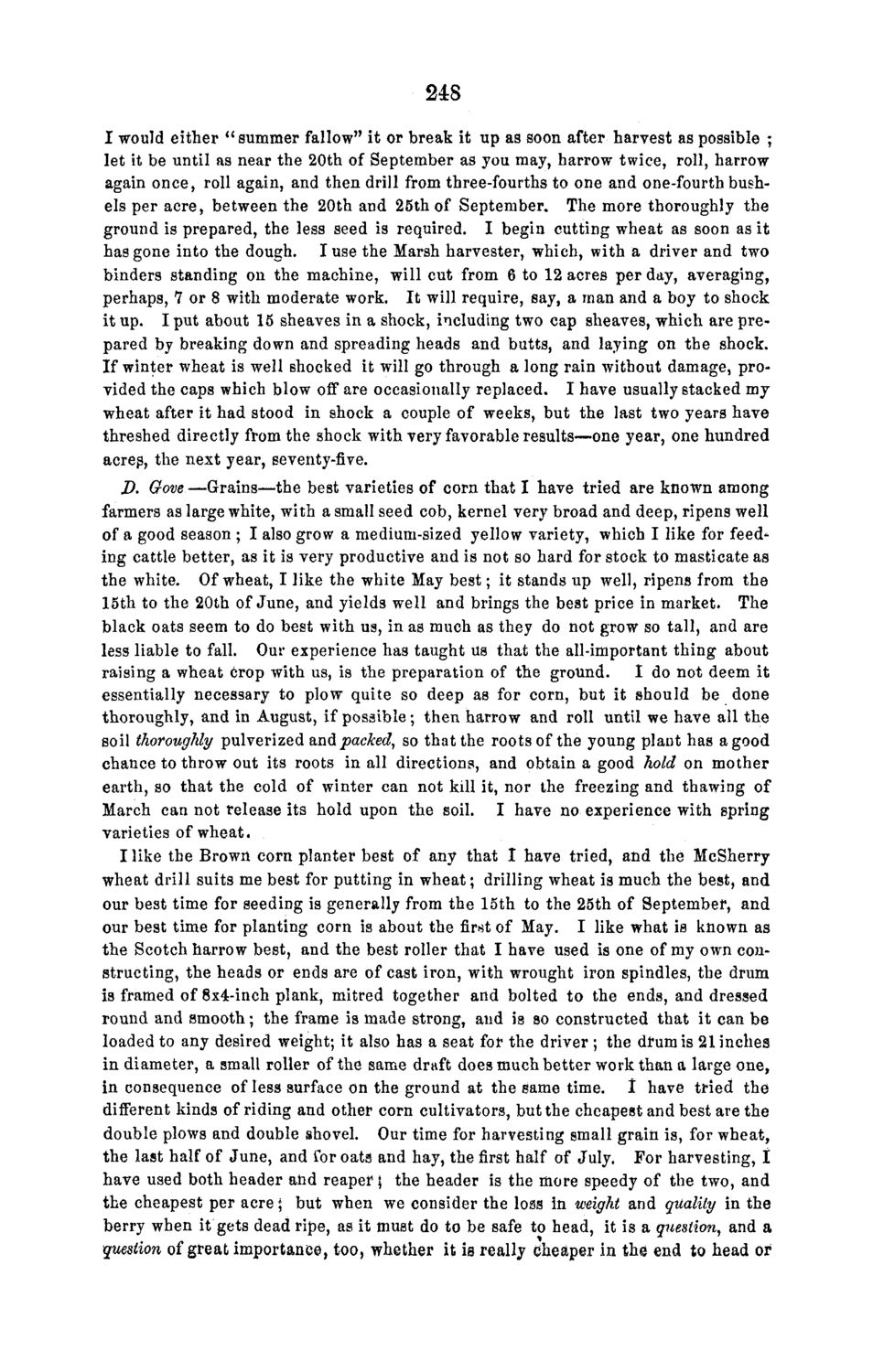| |
| |
Caption: Board of Trustees Minutes - 1868
This is a reduced-resolution page image for fast online browsing.

EXTRACTED TEXT FROM PAGE:
248 I would either "summer fallow" it or break it up as soon after harvest as possible ; let it be until as near the 20th of September as you may, harrow twice, roll, harrow again once, roll again, and then drill from three-fourths to one and one-fourth bushels per acre, between the 20th and 25th of September. The more thoroughly the ground is prepared, the less seed is required. I begin cutting wheat as soon as it has gone into the dough. I use the Marsh harvester, which, with a driver and two binders standing on the machine, will cut from 6 to 12 acres per day, averaging, perhaps, 7 or 8 with moderate work. It will require, say, a man and a boy to shock it up. I put about 15 sheaves in a shock, including two cap sheaves, which are prepared by breaking down and spreading heads and butts, and laying on the shock. If winter wheat is well shocked it will go through a long rain without damage, provided the caps which blow off are occasionally replaced. I have usually stacked my wheat after it had stood in shock a couple of weeks, but the last two years have threshed directly from the shock with very favorable results—one year, one hundred acres, the next year, seventy-five. D. Gove—Grains—the best varieties of corn that I have tried are known among farmers as large white, with a small seed cob, kernel very broad and deep, ripens well of a good season ; I also grow a medium-sized yellow variety, which I like for feeding cattle better, as it is very productive and is not so hard for stock to masticate as the white. Of wheat, I like the white May best; it stands up well, ripens from the 15th to the 20th of June, and yields well and brings the best price in market. The black oats seem to do best with us, in as much as they do not grow so tall, and are less liable to fall. Our experience has taught us that the all-important thing about raising a wheat crop with us, is the preparation of the ground. I do not deem it essentially necessary to plow quite so deep as for corn, but it should be done thoroughly, and in August, if possible; then harrow and roll until we have all the soil thoroughly pulverized and packed, so that the roots of the young plant has a good chance to throw out its roots in all directions, and obtain a good hold on mother earth, so that the cold of winter can not kill it, nor the freezing and thawing of March can not release its hold upon the soil. I have no experience with spring varieties of wheat. I like the Brown corn planter best of any that I have tried, and the McSherry wheat drill suits me best for putting in wheat; drilling wheat is much the best, and our best time for seeding is generally from the 15th to the 25th of September, and our best time for planting corn is about the first of May. I like what is known as the Scotch harrow best, and the best roller that I have used is one of my own constructing, the heads or ends are of cast iron, with wrought iron spindles, the drum is framed of 8x4-inch plank, mitred together and bolted to the ends, and dressed round and smooth; the frame is made strong, and is so constructed that it can be loaded to any desired weight; it also has a seat for the driver ; the drum is 21 inches in diameter, a small roller of the same draft does much better work than a large one, in consequence of less surface on the ground at the same time. I have tried the different kinds of riding and other corn cultivators, but the cheapest and best are the double plows and double shovel. Our time for harvesting small grain is, for wheat, the last half of June, and for oats and hay, the first half of July. For harvesting, I have used both header and reaper; the header is the more speedy of the two, and the cheapest per acre; but when we consider the loss in weight and quality in the berry when it gets dead ripe, as it must do to be safe to head, it is a question, and a question of great importance, too, whether it is really cheaper in the end to head or
| |